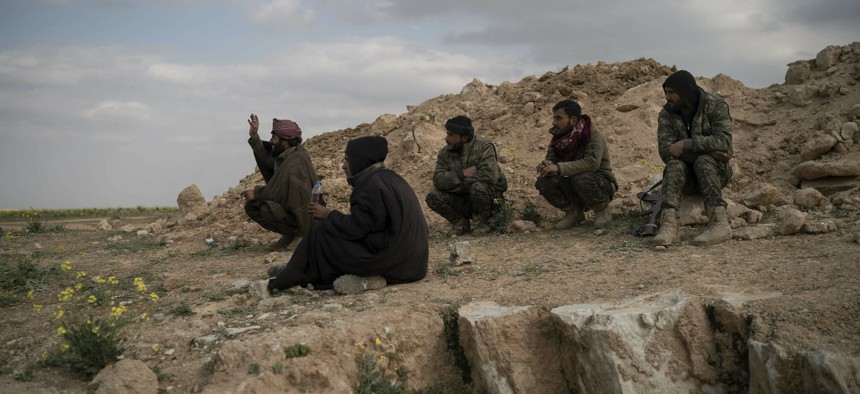
AP Photo/Felipe Dana U.S.-backed Syrian Democratic Forces (SDF) fighters sit atop a hill in the desert outside the village of Baghouz, Syria, Thursday, Feb. 14, 2019. U.S.-backed Syrian forces are clearing two villages in eastern Syria of remaining Islamic State militants.
As ISIS Fight Winds Down in Syria, Detainee Numbers Are Rising
Nearly 1,000 foreign fighters are in custody, U.S. Special Ops commander says — and in legal limbo.
U.S.-backed Kurdish and Arab forces are taking custody of an increasing number of ISIS fighters as the battle to retake the terror group’s last splinter of territory draws to a close, the head of U.S. Special Operations Command told the Senate Armed Services Committee Thursday.
“It's actually closer to 1,000 than it is in the hundreds already in detention, with more potentially to come,” Gen. Tony Thomas said, revising previous public estimates by Defense Department officials of around 700 detainees. Thomas said the captured fighters are “a huge area of concern for us because they’re being maintained by a non-nation state”: the Syrian Democratic Forces, or SDF.
President Trump’s December announcement that the United States would withdrawing its roughly 2,200 troops from Syria added urgency to a tough problem that American diplomats and military leaders were already struggling to solve: What to do with the hundreds of captured foreign fighters held by the SDF. The Pentagon fears that when U.S. forces leave Syria, the SDF will be overrun and will simply release the captured fighters, particularly if they are faced with an attack from Turkish forces, as Ankara has threatened. Some of the captured fighters are thought to be senior leaders, not just foot soldiers, and the United States has contributed at least $1.6 million to shoring up prisons to hold them, according to The New York Times.
Further complicating the situation, international law is unclear about how long a non-state entity can detain prisoners. Although there is little consensus on the solution, the answer is acknowledged within the Pentagon to be somewhere short of “indefinitely.”
Now, the number of detainees appears to be growing at a faster clip, as the SDF and others fight to reclaim the last sliver of territory once held by ISIS. More than 200 fighters holded up in the enclave of Baghouz in eastern Syria gave themselves up on Wednesday — many of them foreign fighters, the Associated Press reported.
The State Department has spearheaded a fierce diplomatic effort to encourage other countries to repatriate their own fighters — ”a surprising number of countries” have recently stepped up to "assume the burden,” Thomas said — but nearly a thousand still remain. There is a “new sense of urgency among our partner nations” since the withdrawal announcement, the top counterterrorism official at the State Department, Nathan Sales, told The New York Times, which pegs the figure of detainees at around 850.
A group of Republican lawmakers, including Sens. John Cornyn of Texas, and Tom Cotton of Arkansas, are pushing the administration to send the worst of the detainees to Guantanamo Bay. That’s a deeply controversial suggestion, one that a U.S. official told the AP last week was “the option of last resort.”
At issue is whether ISIS can be legally considered to be “an associated force” of al Qaeda. The Obama and Trump administration both asserted as much as the legal justification to prosecute the war against the group under the congressional authorization passed in 2001 to invade Afghanistan. In order to hold someone as an enemy combatant under U.S. law, the government must be able to prove that the detainee is a member of a group with whom it is in an armed conflict. The courts have never weighed in on the question of whether ISIS qualifies — the group splintered off from al Qaeda in 2014 — and legal experts say that any effort to send an ISIS detainee to Guantanamo Bay would almost certainly invite immediate legal challenges from the detainees themselves on that basis.
Any fighter taken into American custody and sent to Guantanamo Bay would be entitled to a lawyer. Further, if any of the fighters are U.S. citizens, recent precedent suggests that U.S. courts could intervene to demand they be given access to a lawyer while still in Syria.
Officials have identified about 50 “high-value” subjects who could be sent to Guantanamo, said the U.S. official quoted by the AP. But while State and Defense officials have insisted that the option remains open, they have been mum on whether the administration has obtained an official opinion justifying the case that such a transfer would be legal under the 2001 Authorization for the Use of Military Force.
“The [U.S. government’s] policy is to encourage countries of citizenship to take responsibility for their FTFs through prosecution, rehabilitation programs, or other measures that sufficiently prevent detainees from re-engaging in terrorism,” Pentagon spokesperson Candice Tresch said in a statement, using an acronym for foreign terrorist fighters. “The USG is pursuing multiple alternative disposition options for those FTFs who cannot be repatriated.”
Former President Barack Obama tried and failed to shutter the facility, stymied in part by domestic opposition to transporting any of the prisoners onto mainland U.S. soil. Several dozen aging detainees still remain, only nine of whom have been charged with war crimes. Their trials, by military commissions established in the wake of the Sept. 11 attacks, have dragged on for years through a quagmire of process disputes.
On the campaign trial, Trump vowed to fill the prison up with “bad dudes” and in his State of the Union speech last year, he formally announced that he would be keeping the prison open. But stymied by the snarl of legal challenges with sending ISIS fighters to the snarl, he has so far released one prisoner and added no new captives.
No new prisoner has been sent to Gitmo since March 2008.
NEXT STORY: State of Defense 2019: Special Report
